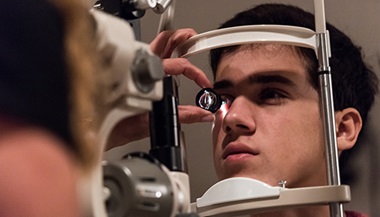Glaucoma Surgery Recovery: What You Need to Know
Featured Expert
Glaucoma surgery is a procedure intended to reduce eye pressure and help prevent future vision loss resulting from glaucoma. Ophthalmologist Thomas Johnson III, M.D., Ph.D., from the Wilmer Eye Institute, Johns Hopkins Medicine, provides essential information to keep in mind as you recover from your surgery.
Types of Glaucoma Surgeries
There are several types of procedures that aid in eye pressure reduction by doing one of the following:
- Increasing the drainage of eye fluid through the natural drainage pathways of the eye.
- Creating a new opening or pathway for fluid to drain from the eye (such as by implanting a tube shunt to help drain the fluid).
- Slowing down the speed at which the eye produces fluid.
Microinvasive glaucoma surgeries (MIGS): These surgeries involve an approach entirely inside the eyeball, and do not include changes or implants to the outside of the eye. This approach generally results in quick recovery time and relatively low risk of complications.
Some types of procedures, such as trabeculectomy or tube shunt implantation, have a higher level of risk, but are generally more effective at lowering eye pressure than MIGS. Other types of glaucoma surgery are conducted in the operating room, but involve only the use of lasers, without incisions or stitches in the eye.
What Should I Expect After Glaucoma Surgery?
Although surgery can lower eye pressure and help stabilize vision for a long time, your doctors will need to monitor your glaucoma during that time. It is important to understand that glaucoma surgery generally does not improve or restore vision that has already been lost. The surgery prevents future vision loss from glaucoma.
Blurry vision in the operated eye is common during the immediate recovery period. Your vision will improve over the weeks that follow. Other common temporary effects to the eye after surgery include:
- Redness
- Irritation
- Eyelid swelling
- Tearing
- Foreign body sensation (the feeling of sand or grit on the eye)
You may be given a shield to wear over the eye to prevent bumping or rubbing your eye (especially while you are sleeping); however, some procedures do not require a shield.
Most of the time, your eyedrop prescriptions will change after your procedure. Depending on the surgery, your doctor may stop one or more of your glaucoma eyedrops and/or prescribe new eye drops to hasten recovery.
Most people who have glaucoma surgery do not experience significant pain. If you do feel pain in the eye, you should consult your eye doctor about the best options to relieve it.
What Role Will My Eye Doctor Play During Recovery?
You will have multiple appointments with your eye care team during the recovery period to make sure your eye is healing correctly. “Some forms of glaucoma surgery, including trabeculectomy, can be modified in the postoperative period to encourage long-term function,” says Johnson. “For instance, your eye doctor might remove releasable sutures from the eye or melt stitches placed underneath the outer covering of the eye using a laser. This works best only during the first few weeks after surgery, and so attending all your postoperative appointments is critical.”
Generally, patients are seen the day after surgery, and then every one to three weeks for two to three months. Additional visits are spaced out further after that. Your doctor will review your glaucoma medications schedule, including when you should resume using them and how much you should take.
During recovery, consult with your eye doctor if you experience any of the following symptoms, which could be a sign of infection or other complication:
- Severe pain in the eye
- Worsening redness in the eye
- Pus or thick discharge from the eye
- Decreasing vision
- A shadow in the visual field
How Long Does It Take to Recover from Glaucoma Surgery?
Recovery from glaucoma surgery varies, depending on the surgery. Most people notice recovery in vision in days to weeks after the surgery. Instances of months-long recovery are possible, although very uncommon.
“Visual recovery depends on the surgery and on the eye’s healing response,” says Johnson. “Some patients see as well the day after surgery as they did before, and experience no discomfort. This is more common with MIGS procedures, since they have minimal effect on the shape of the eye and use only tiny incisions and often no stitches. Recovering from other glaucoma surgeries, including trabeculectomy and tube shunt surgery, can take longer,” says Johnson.
Recovery from glaucoma surgery can be slowed in cases of severe glaucoma and by other factors, such as use of blood thinners or the eye’s reaction to the procedure.
What Am I Able to Do After Glaucoma Surgery?
It’s important to consult with your eye doctor for specific timelines regarding your recovery. Caution should be taken when eye pressure is low, and patients should avoid heavy lifting, bending over, vigorous activity or straining. When pressure normalizes, most people should be able to return to light job duties in one or two weeks.
Most people can resume daily activities such as reading, watching TV or using phones, computers or other electronic devices within the first few days following surgery. Showering and bathing may also resume. Eye protection (a shield or glasses) may be used to prevent bumping or rubbing the eye.
“Because of the sedation used during glaucoma surgery, you will not be able to drive for a day following your procedure, so you will need to find someone to accompany you home,” says Johnson. “After the patch is removed the day after surgery, some patients may be able to resume driving. This is based on level of vision in both eyes and your comfort level in safely operating a vehicle during the recovery period.”
What Should I Avoid Following Glaucoma Surgery?
For procedures in which eye pressure is low, avoid the following activities until otherwise directed by your doctor:
- Exercise: Although gentle walking is usually OK, we recommend people avoid any level of exercise that causes significant elevation in heart rate, breathlessness or sweating.
- Lifting more than 10 pounds
- Bending over at the waist
- Straining
You should also avoid these activities, which can cause infection from bacteria:
- Swimming or using hot tubs; depending on the surgery, there may be a lifelong precaution in this regard.
- Wearing reusable contact lenses; sometimes the surgeon will place a specific contact to hasten healing.
- Wearing eye makeup or face cream
Your eye care team will provide more detailed timelines and directions for your recovery after your procedure.







